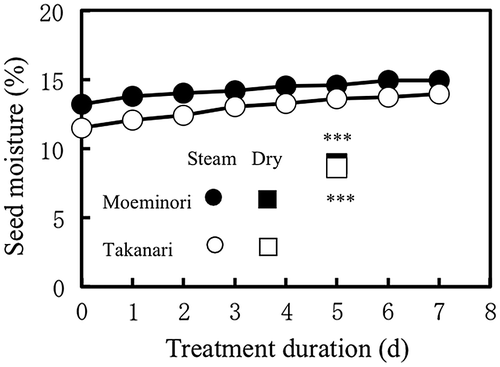Figures & data
Table 1. Dormancy classification with percentage of germination and the 50% germination time (T50S).
Table 2. Seed materials and dormancy of the seeds used in the four experiments for control.
Figure 1. Germination percentage of the dormant and non-dormant seeds subjected to steam treatments using the steam cabinet for 7 d (Exp. 1). Untreated seeds were used as the control. Vertical bars indicate standard errors (n = 4). * and ** indicate significant differences between the steam treatment and the control for the slightly dormant and non-dormant seeds at p < .05 and .01, respectively, (logistic regression).
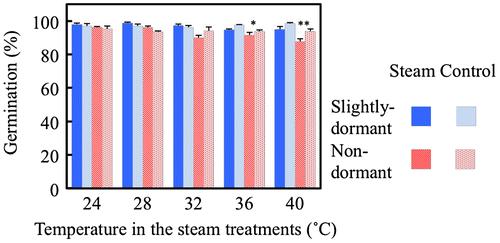
Figure 2. The 50% germination time (T50S, based on the number of seeds) of the slightly dormant and non-dormant seeds subjected to steam treatments using the steam cabinet for 7 d (Exp. 1). Untreated seeds were used as the control. Vertical bars indicate standard errors (n = 4). * and *** indicate significant differences between the steam treatment and the control for the slightly dormant and non-dormant seeds at p < .05 and .001, respectively (ANOVA).

Figure 3. Germination percentage of the three cultivars subjected to steam treatments using the steam cabinet at 40 °C for 5 and 7 d (medium dormant ‘Hitomebore’ and highly dormant ‘Takanari’) and for 1–7 d (medium dormant ‘Moeminori’) and dry heat treatments at 50 °C for 5 and 7 d (Exp. 2). Vertical bars indicate standard errors (n = 4). Means followed by the same letters for each cultivar are not significantly different at p < .05 (Ryan’s method).
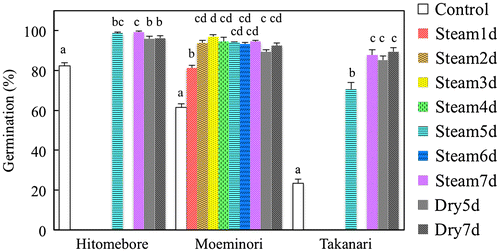
Figure 4. The 50% germination time (T50S; based on the number of seeds) of the three cultivars subjected to steam treatments using the steam cabinet at 40 °C for 5 and 7 d (medium dormant ‘Hitomebore’ and highly dormant ‘Takanari’) and for 1–7 d (medium dormant ‘Moeminori’) dry heat treatments at 50 °C for 5 and 7 d (Exp. 2). Vertical bars indicate standard errors (n = 4). Means followed by the same letters for each cultivar are not significantly different at p < .05 (Tukey’s method). NA: not available for control because the germination percentage was < 50%.

Figure 5. Moisture in ‘Moeminori’ seeds subjected to steam treatments at 40 °C using the steam cabinet and dry heat treatments at 50 °C (Exp. 2). Note that vertical bars are used to denote the standard errors. However, the depicted bars are smaller than the symbols used, so they are not clearly discernible. *** indicates significant differences between the two treatments at p < .001 (ANOVA).
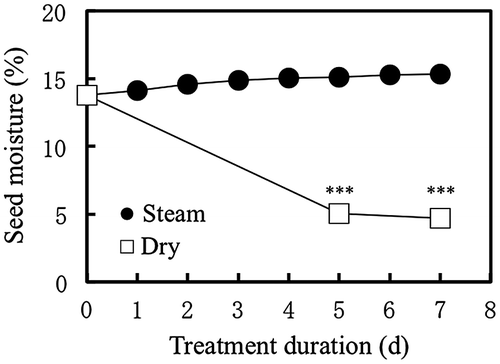
Figure 6. Germination percentage of highly dormant ‘Takanari’ seeds subjected to steam treatments using the steam cabinet at 40 °C for 7 to 13 d and dry heat treatments at 50 °C for 7 d (Exp. 3). Vertical bars indicate standard errors (n = 4). However, the depicted bars are smaller than the symbols used, so they are not clearly discernible. Means followed by the same letters for each treatment are not significantly different at p < .05 (Ryan’s method).
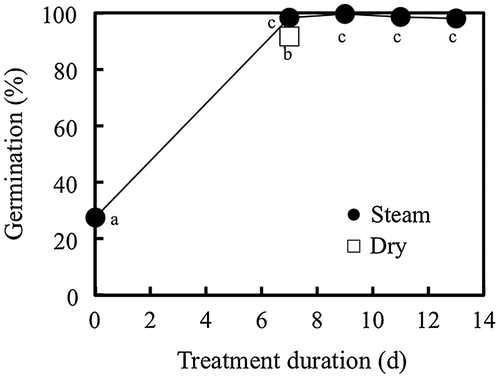
Figure 7. The 50% germination time (T50S; based on the number of seeds) of highly dormant ‘Takanari’ seeds subjected to steam treatments using the steam cabinet at 40 °C for 7 to 13 d and dry heat treatments at 50 °C for 7 d (Exp. 3). Vertical bars indicate standard errors (n = 4). However, the depicted bars are smaller than the symbols used, so they are not clearly discernible. Means followed by the same letters for each treatment are not significantly different at p < .05 (Tukey’s method). T50S of the control was not available because the germination percentage was < 50%.
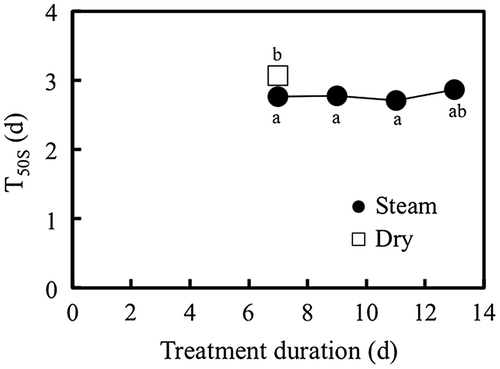
Figure 8. Moisture in ‘Takanari’ seeds subjected to steam treatments using the steam cabinet and dry heat treatments (Exp. 3). Note that vertical bars are used to denote the standard errors. However, the depicted bars are smaller than the symbols used, so they are not clearly discernible. *** indicates significant differences between the two treatments at p < .001 (ANOVA).
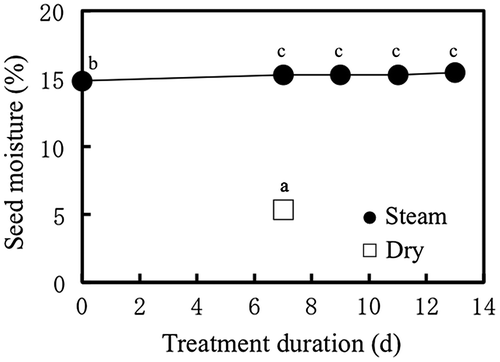
Figure 9. Germination percentage of non-dormant ‘Moeminori’ and ‘Takanari’ subjected to steam treatments using the steam cabinet at 40 °C for 1–7 d and dry heat treatments at 50 °C for 5 d (Exp. 4). Vertical bars indicate standard errors (n = 4). Means followed by the same letters for each cultivar are not significantly different at p < .05 (Ryan’s method).
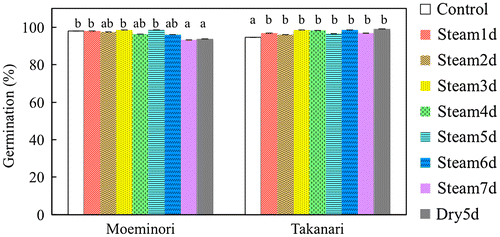
Figure 10. The 50% germination time (T50S; based on the number of seeds) of non-dormant ‘Moeminori’ and ‘Takanari’ subjected to steam treatments using the steam cabinet at 40 °C for 1–7 d and dry heat treatments at 50 °C for 5 d (Exp. 4). Vertical bars indicate standard errors (n = 4). Means followed by the same letters for each cultivar are not significantly different at p < .05 (Tukey’s method).
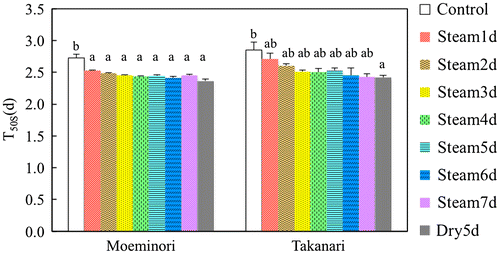
Figure 11. Moisture in non-dormant ‘Moeminori’ and ‘Takanari’ seeds subjected to steam treatments using the steam cabinet at 40 °C for 1–7 d and dry heat treatments at 50 °C for 5 d (Exp. 4). Note that vertical bars are used to denote the standard errors. However, the depicted bars are smaller than the symbols used, so they are not clearly discernible. *** indicates significant differences between the two treatments at p < .001 (ANOVA).
